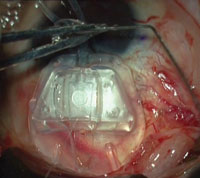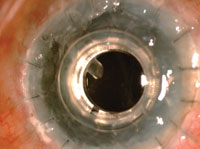Ahmed glaucoma valve can be used in complex situations
Complications are possible with the device, so greater surgical skill and close attention to detail are required.
Glaucoma drainage devices are generally used to lower IOP in cases of refractory glaucoma. They act by allowing aqueous humor to drain into an extrascleral reservoir through a small-caliber tube.
Surgical technique
For adults, we prefer the FP7 model of the Ahmed glaucoma valve (AGV, New World Medical), which has a unidirectional mechanism of action. It is made of medical grade silicone and has a 13 mm 3 16 mm plate and a tube. Our insertion technique consists of making a conjunctival peritomy and creating space under Tenon’s capsule. The valve is primed using balanced salt solution and a 27-gauge cannula (Figure 1), and it is inserted under Tenon’s capsule in between the recti until it is about 8 mm to 10 mm from the limbus. Any impingement on the recti should be carefully avoided to prevent postoperative diplopia.

Figure 1. An adult model AGV being primed before insertion.

Figure 2. Tube migration is avoided by an oblique passage through the sclera, an anchoring scleral stay suture and a tight flap.
Images: Agarwal A
Once sutured, the position of the flap is marked, and a superficial scleral flap is dissected. Flaps that are too thin are avoided to prevent tube erosion. A 23-gauge needle is used to enter the anterior chamber under the flap, making an oblique passage through the sclera. The tube is cut to its desired length with a 30° bevel. It is then inserted into the anterior chamber, and its position is verified. Once the surgeon is satisfied, the flap is sutured over the tube, making sure that the tube cannot move under the flap. Fibrin glue, if available, seals the flap completely around the tube. A stay suture is also applied around the tube and anchored to the sclera. We believe these three simple steps prevent tube migration (Figure 2). The peritomy is then closed. The conjunctiva may be closed using fibrin glue, making sure that the glue is not applied posteriorly but only at the anterior edge at the limbus. The glue should not seal off the posterior conjunctival space.
Complex situations
A pre-existing trabeculectomy or a previous AGV implantation might preclude implantation in the superotemporal quadrant, which is generally the preferred site for AGV implantation. In this case, one can implant the valve superonasally to lie in between the superior and medial recti. The other steps remain the same. It may also be implanted inferotemporally to lie in between the inferior and lateral recti.
Tube-corneal endothelial touch can cause corneal decompensation and should be avoided at all costs. For this reason, in pseudophakic eyes, we prefer tube implantation in the posterior chamber in between the iris and the IOL. This is accomplished in the same way except that the needle is directed toward the posterior chamber parallel to the posterior iris surface. This keeps a safe distance between the tube and the corneal endothelium and avoids long-term corneal decompensation. In phakic eyes, the tube is placed in the anterior chamber. However, it should be avoided in quadrants with peripheral anterior synechiae because it might result in anterior placement of the tube with a resultant corneal touch. In such cases, a different quadrant may be selected, or it may be placed in the posterior chamber after performing a cataract extraction.
Regardless of anterior chamber or posterior chamber implantation, the tube needs to remain parallel to the iris to avoid iris pigment dispersion as well as iris plugging. A large flaccid iris may require an iridoplasty. Careful insertion should be done to avoid damage to the iris root or the ciliary body and hyphema.
We also utilize intravitreal placement of the AGV tube in selected cases, including patients with an absent posterior capsule or a secondarily scleral-fixated IOL. In this case, it is essential to perform a thorough anterior vitrectomy to prevent vitreous strands from occluding the tube. We then perform additional vitrectomy near the tube tip and avoid tube migration with an oblique passage through the sclera, the anchoring stay suture and a tight flap.
We use the pediatric FP8 model for cases of refractory glaucoma in children and have found encouraging results. We also use the AGV in cases of post-penetrating keratoplasty glaucoma. Such eyes generally have deformed anterior segments and large areas of peripheral anterior synechiae. Trabeculectomy with or without antimetabolites may fail in such eyes. The AGV, by acting as a drainage device, can be combined with other anterior segment reconstructive procedures such as secondary IOL fixation or pupilloplasty to get good postoperative results. We fix the tube tip behind the iris, in front of the IOL, in such cases or in the anterior vitreous after a thorough vitrectomy in eyes with no posterior capsule.

Figure 3. An AGV is often combined with a Boston keratoprosthesis.
Image: Agarwal A
Other patients that require special consideration are those undergoing Boston keratoprosthesis (KPro) implantation. These patients sometimes develop increased IOP in the postoperative period, especially if they also have deformed, complex anterior segments. Measuring IOP in the presence of a Boston KPro is difficult, and often the surgeon relies only on digital estimation. We prefer to have a low threshold for implanting an AGV in such patients and often combine the two procedures (Figure 3). The tube is placed in front of the IOL in case of a pseudophakic Boston KPro with an intact posterior capsule. In case of a monocameral eye or in an eye with an aphakic Boston KPro and absent posterior capsule, a thorough vitrectomy is done to prevent vitreous from clogging the tube tip. We do not routinely use the pars plana clip for pars plana placement of the AGV but rather use a more oblique entry through the scleral wall as well as a stay suture on the tube.
Complications
Careful attention should be paid to the tube. Any inflammation within the eye needs to be treated aggressively before it causes a block in the tube tip. Vitreous blocking the tube tip might need a vitrectomy. A tube that is too long may remain in the visual axis and cause symptoms, and it may need to be removed from the anterior chamber, shortened and replaced. Other tube-related complications include tube migration, tube erosion, tube-corneal touch, tube-lenticular touch and tube-iris touch.
The tube tip is sometimes difficult to see and may require anterior segment optical coherence tomography to visualize. Anterior segment OCT can visualize the tube tract under the sclera and conjunctiva as well as the plate of the AGV. It may also be used to visualize the tip of the tube and the presence of any block.
Although we routinely elevate a lamellar scleral flap for tube coverage, a donor scleral patch graft, a scleral autograft or preserved dura might be used to cover the tube primarily or secondarily if it is exposed. This has the disadvantage of requiring donor tissue or additional site surgery.
Early postoperative hypotony can be avoided by using a Vicryl suture for temporarily ligating the tube. This helps avoid attendant complications such as choroidal effusion and suprachoroidal hemorrhage. Late hypertensive phase, if it occurs, may be managed medically. Bleb encapsulation and fibrosis leading to increased IOP and failure may be managed by a second AGV implantation or by needling the bleb.
Conclusion
To conclude, we have found encouraging results with the AGV, but it requires greater surgical skill, meticulousness and close attention to surgical details.
